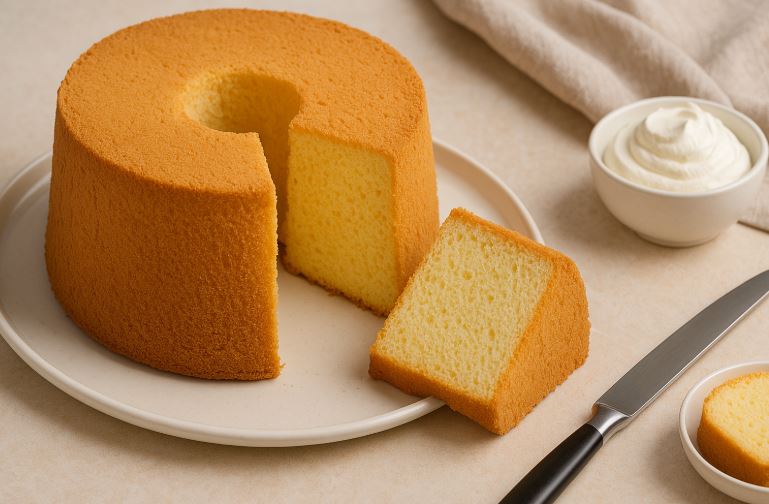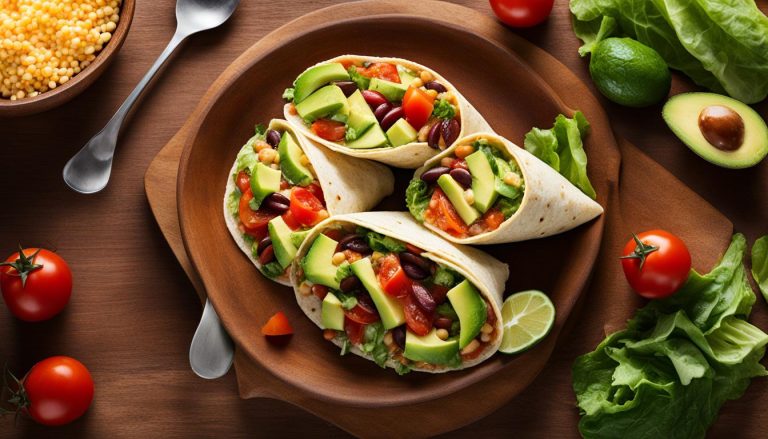As a passionate home baker, I’ve always admired the light, airy elegance of a well-made chiffon cake. Unlike denser cakes, chiffon offers a beautifully moist crumb without feeling heavy. Its delicate texture and versatility make it a staple in my kitchen.
In this blog, I’ll guide you through my go-to chiffon cake recipe, perfected over years of baking, along with expert tips and delicious flavour variations I truly recommend.
What is Chiffon Cake?
When I first encountered a chiffon cake, I was taken aback by its uniquely soft texture. It’s not quite a sponge, nor is it a butter cake; it sits gracefully between the two, combining the best qualities of each. Chiffon cake is made with oil rather than butter, which results in a moister crumb and a lighter body.
Invented in the 1920s by Harry Baker, a Californian insurance salesman turned baker, the chiffon cake remained a closely guarded secret for years until General Mills acquired the recipe in the late 1940s.
The technique was revolutionary, introducing whipped egg whites to a rich, oil-based batter, producing a cake that was both airy and rich.
What Makes It Different?
- Oil-Based: Unlike butter cakes, oil helps maintain moisture even after refrigeration.
- Whipped Egg Whites: Similar to angel food cake, it uses beaten egg whites to create that airy rise.
- Tube Pan Baking: Cooled upside down to prevent collapse, this step is essential.
Chiffon cakes can be flavoured with vanilla, citrus zest, chocolate, matcha, or coffee, and are commonly served plain, glazed, or with whipped cream and fruit.
What Ingredients Do I Need for a Chiffon Cake?
I’ve refined this recipe after testing variations from Preppy Kitchen, BBC Good Food, and Sugar & Crumbs. Below is the foundation for a standard vanilla chiffon cake that you can easily customise.
Ingredient Table
| Ingredient | Quantity | Notes |
| Cake flour | 180g | Sifted twice |
| Caster sugar | 200g | Divided – 130g for yolks, 70g for whites |
| Large eggs | 6 | Separated carefully |
| Baking powder | 1 tbsp | Ensure it’s fresh |
| Salt | ½ tsp | Enhances flavour |
| Vegetable oil | 120ml | Neutral oil like sunflower or canola |
| Water | 180ml | Room temperature |
| Vanilla extract | 1½ tsp | Use pure extract for best results |
| Cream of tartar | ½ tsp | Stabilises whipped egg whites |
Notes on Technique
- Eggs must be at room temperature for best volume.
- Don’t overmix after folding in the egg whites, use a large spatula with a gentle hand.
- The pan should not be greased, this allows the batter to cling and rise properly.
Why Egg Separation Matters?
Separating eggs might sound tedious, but trust me, it’s where the magic lies. The whites are beaten to soft or stiff peaks, incorporating air that gives chiffon its signature lightness. This step can’t be skipped or rushed.
The Role of Whipped Whites
- Soft Peaks: Ideal for most chiffon cakes; they hold shape but fold easily.
- Cream of Tartar: Aids in stabilising the foam and maintaining structure.
- Clean Equipment: No yolks in the whites and grease-free bowls are crucial.
The yolks, mixed with oil and liquids, add richness and moisture. It’s the blending of these two mixtures that gives chiffon its luxurious mouthfeel.
How to Make the Perfect Chiffon Cake? – Step-by-Step
Making a chiffon cake might seem delicate, but once you’ve got the rhythm, it’s truly rewarding. Here’s my personal step-by-step method, refined from trusted references like Preppy Kitchen and Serious Eats, and from my own baking journey.
Step 1: Prepare Your Tools and Ingredients

- Use a clean, dry bowl for the egg whites, any grease will prevent proper whipping.
- Preheat your oven to 160°C fan (or 170°C conventional).
- Sift the flour, baking powder, and half the sugar (for the yolk mix) twice for airiness.
Step 2: Mix the Egg Yolk Batter

- In a large bowl, whisk together: Egg yolks (6), 130g caster sugar, Oil (120ml), Water (180ml), Vanilla extract (1½ tsp)
- Once combined, add sifted dry ingredients and whisk until smooth and lump-free.
Step 3: Whip the Egg Whites
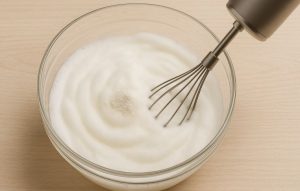
- Beat egg whites (6) on medium speed until foamy.
- Add cream of tartar (½ tsp) and continue whipping.
- Gradually add the remaining 70g of sugar until soft peaks
Step 4: Fold the Whites into the Batter
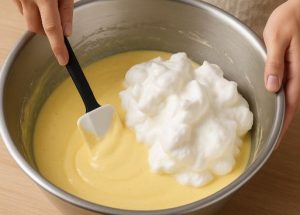
- Add one-third of the whites to loosen the yolk batter, don’t worry about deflating here.
- Gently fold in the rest with a spatula in a figure-eight motion, be patient and light-handed.
Step 5: Pour and Bake
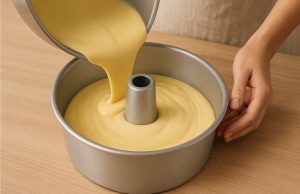
- Pour the batter into a 10-inch ungreased tube pan. Tap once to release large bubbles.
- Bake on the lower-middle rack for 50–60 minutes.
- The cake should be golden, springy to the touch, and pass the skewer test.
Step 6: Invert and Cool
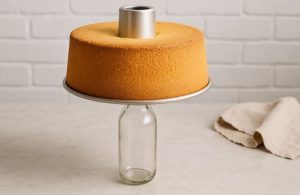
- Immediately invert the pan onto its legs or over a bottle neck.
- Cool for at least 1½ hours before unmoulding.
- Run a knife along the edges and base gently to release.
Step 7: Slice and Serve
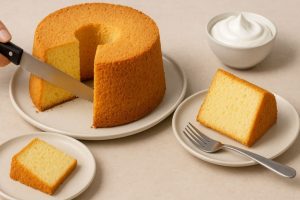
- Use a serrated knife for clean slices.
- Serve plain, with whipped cream, or glaze as preferred.
Common Mistakes to Avoid When Baking Chiffon Cake
Even seasoned bakers can fall victim to chiffon mishaps. Here are some common errors I’ve learned to dodge.
What to Watch For?
- Overmixing the batter after folding in egg whites results in a dense cake.
- Greasing the pan, the batter won’t rise properly.
- Skipping the upside-down cooling leads to deflated cakes.
- Using cold eggs prevents full aeration during whipping.
A tip from Serious Eats: if you’re baking in a humid climate, slightly reduce the water content or add a touch more flour to maintain structure.
Can I Make Chiffon Cake Gluten-Free or Dairy-Free?
I’ve successfully made chiffon cakes gluten-free and dairy-free, and the results are just as satisfying when you get the balance right.
Flour and Liquid Substitutes
- Gluten-Free: Use a blend of rice flour and tapioca starch or a pre-made gluten-free cake mix.
- Dairy-Free: Swap water with almond milk or coconut milk for additional flavour.
- Oil Substitute: Light olive oil or avocado oil can work well.
Nutritional Table (Standard Slice – Gluten-Free Version)
| Nutrient | Amount per Slice |
| Calories | 210 kcal |
| Fat | 9g |
| Carbohydrates | 30g |
| Sugars | 18g |
| Protein | 4g |
| Fibre | 1g |
If you’re avoiding eggs entirely, it gets tricky, but using aquafaba (whipped chickpea water) has worked moderately well for me in vegan adaptations.
How to Store and Serve Chiffon Cake?
Keeping It Fresh and Elegant
Chiffon cake stays lovely for up to three days at room temperature and up to a week when refrigerated in an airtight container.
My Serving Suggestions
- With light whipped cream and strawberries
- Glazed with lemon icing
- Layered with pastry cream for a fancier dessert
Always slice with a serrated knife for clean edges.
Tools I Use for the Perfect Chiffon Cake
Some items are non-negotiable in my chiffon-baking routine.
My Go-To Tools
- 10-inch ungreased tube pan with feet for inverted cooling
- Hand or stand mixer for beating egg whites
- Large silicone spatula for gentle folding
- Fine mesh sifter for flour and sugar
- Digital kitchen scale for accuracy
Good tools make baking efficient and consistent.
Variations of Chiffon Cake Recipe
I love how adaptable chiffon cake is. Once you’ve mastered the base recipe, these variations are seamless to incorporate. Below, I’ve included my seven favourite twists, each one tested and refined in my own kitchen.
Vanilla Chiffon Cake – Based on AllRecipes’ Original Formula
This is the classic version I always recommend to beginners. It uses a simple vanilla flavour profile that lets the cake’s texture shine.
How to Make It:
- Use the base recipe exactly as provided in the ingredients table.
- Add 2 tsp pure vanilla extract instead of 1½ tsp for a richer note.
- Bake at 160°C for 55 minutes.
- Cool inverted and serve with a dusting of icing sugar or vanilla glaze.
Serving tip: Perfect with berries or a dollop of whipped cream.
Lemon Chiffon Cake – A Zesty Update from BBC Good Food Users
Lemon adds brightness and cuts through the richness of the oil-based cake. This version is light, fragrant, and summery.
How to Make It:
- Reduce water to 150ml, and add 30ml freshly squeezed lemon juice.
- Add 2 tbsp lemon zest to the yolk batter.
- Use a lemon glaze made from icing sugar and juice to finish once cooled.
Pro tip: Don’t use bottled juice, the freshness makes all the difference.
Orange Chiffon Cake – Sophie Bamford’s Charming Citrus Twist
This recipe draws inspiration from Sophie Bamford’s writing, where she highlights the beauty of seasonal citrus.
How to Make It:
- Replace water with 180ml fresh orange juice.
- Add 2 tbsp finely grated orange zest to the yolk mix.
- Top with an orange icing or marmalade glaze.
Extra tip: Add a splash of orange blossom water for a floral depth.
Chocolate Chiffon Cake – Rich Cocoa Addition from Preppy Kitchen
Preppy Kitchen’s version balances decadence with airiness, producing a chocolate cake that’s indulgent yet light.
How to Make It:
- Replace 30g of the cake flour with 30g of unsweetened cocoa powder.
- Add 1 tsp instant espresso powder to intensify the chocolate.
- Use hot water instead of room temp to bloom the cocoa fully.
Serving idea: A dark chocolate ganache glaze takes it over the top.
Coconut Chiffon Cake – Serious Eats Adds Shredded Coconut and Milk
This tropical-inspired version has a tender crumb and subtle sweetness, making it ideal for spring or summer events.
How to Make It:
- Substitute water with 180ml of coconut milk.
- Fold in ½ cup finely shredded desiccated coconut before baking.
- Optional: Add a few drops of coconut extract for extra flavour.
Finishing Touch: Top with coconut whipped cream and toasted flakes.
Matcha Chiffon Cake – Zhang Catherine’s Stunning Green Variation
Matcha brings a bold, earthy tone and beautiful colour. This version has become a staple in my kitchen thanks to Zhang Catherine’s notes.
How to Make It:
- Whisk 2 tbsp matcha powder into the flour mixture.
- Use 175ml of water to adjust for matcha’s drying effect.
- Optional: Fold in white chocolate chips for sweetness.
Best served with: Light whipped cream and a dusting of extra matcha.
Berry-Infused Chiffon – Sugar & Crumbs Offers a Fruity Delight
This vibrant version uses freeze-dried berry powders or berry essences for flavour without disrupting structure.
How to Make It:
- Add 2 tbsp freeze-dried strawberry or raspberry powder to the dry ingredients.
- Use 170ml berry juice or berry-flavoured water instead of plain water.
- Consider adding a few drops of berry essence if using natural juice.
Topping: A swirl of berry compote or mascarpone frosting pairs beautifully.
Conclusion
Chiffon cake is a celebration of balance, light yet rich, delicate yet indulgent. Whether you’re baking for a gathering or treating yourself to something special, this recipe provides a reliable base with endless variation potential.
With the right techniques and quality ingredients, anyone can master this elegant cake. I hope my step-by-step guide inspires you to try your own version. It’s one of those bakes that’s always worth perfecting.
Frequently Asked Questions
What’s the difference between chiffon cake and sponge cake?
Chiffon cake uses oil and baking powder, resulting in a moister and richer texture compared to sponge cake.
Can I bake a chiffon cake in a regular round tin?
You can, but results vary. A tube pan allows the cake to rise evenly and cool upside down to avoid collapse.
Why did my chiffon cake collapse after baking?
It likely wasn’t cooled upside down, or the egg whites were overbeaten or underbeaten, disrupting the structure.
Can I make mini chiffon cakes or cupcakes?
Yes, but reduce the baking time to 15–20 minutes and use paper liners. They’ll be just as fluffy!
What’s the best way to flavour chiffon cake?
You can use citrus zest, matcha powder, chocolate, or fruit extracts. Adjust liquid levels to maintain consistency.
How can I tell when the cake is done?
Insert a skewer in the centre, and it should come out clean. The top should be golden and slightly springy to the touch.


